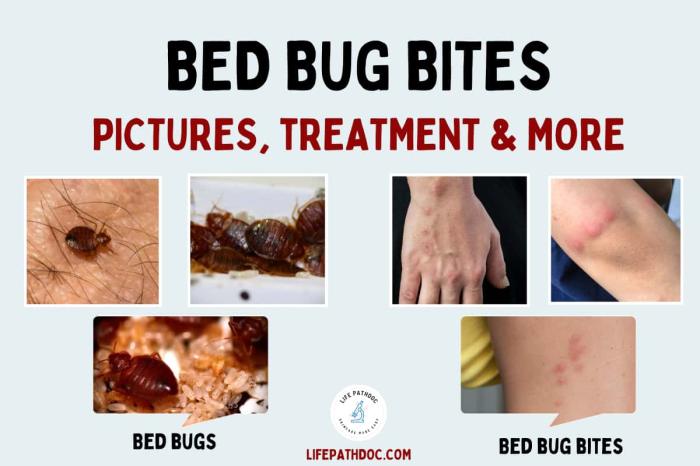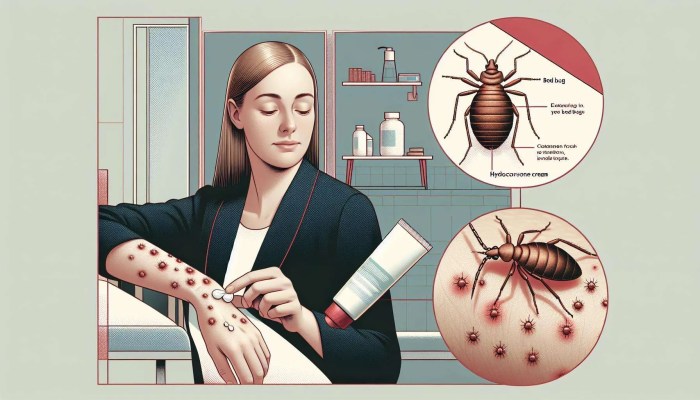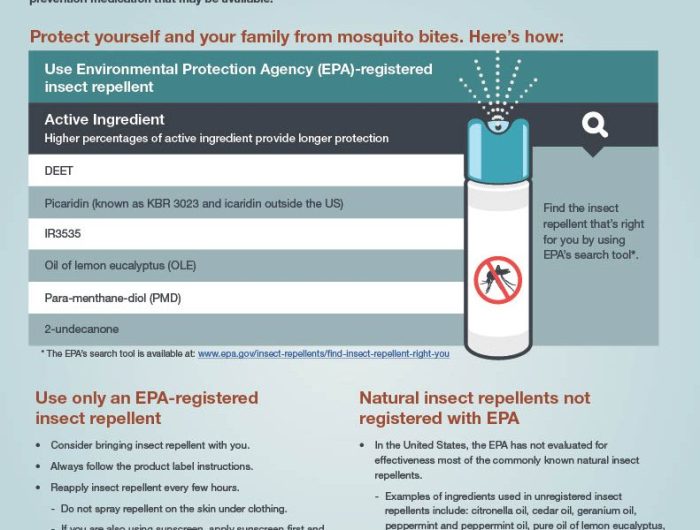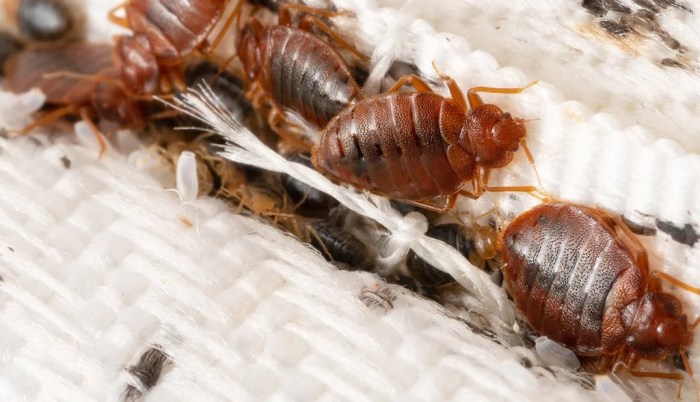How to treat bed bug bites effectively and safely is a crucial step in managing the discomfort and potential complications associated with these tiny pests. This guide provides a detailed look at identifying bed bug bites, immediate actions, home remedies, over-the-counter treatments, professional options, preventing future bites, and managing symptoms. We’ll cover everything from recognizing the tell-tale signs to dealing with potential allergic reactions.
Understanding the specifics of bed bug bites is vital for effective treatment. Knowing how to distinguish them from other insect bites and implementing the right remedies can significantly ease the discomfort and prevent secondary infections. This guide offers a practical approach to addressing these pesky bites, providing actionable steps for every stage of the process.
Identifying Bed Bug Bites
Bed bug bites can be tricky to spot, as they often resemble bites from other insects. Understanding the unique characteristics of bed bug bites can help you distinguish them from other insect infestations. Accurate identification is crucial for effective treatment and prevention.Identifying bed bug bites requires a careful examination of the affected area and a comparison with other insect bites.
It is important to pay attention to the appearance, location, and timing of the bites, as these factors can provide valuable clues.
Typical Appearance of Bed Bug Bites
Bed bug bites typically appear as small, itchy red bumps. They often appear in clusters, commonly arranged in a linear pattern or in a row. The bites themselves are usually small, ranging from a few millimeters to a couple of centimeters in diameter. Sometimes, the bites may be grouped together, forming a small cluster of bumps. The shape of each bite can vary, but they are usually slightly raised and inflamed.
The intensity of itching can vary from person to person.
Distinguishing Bed Bug Bites from Other Insect Bites
Bed bug bites differ from those of other insects in several ways. Mosquito bites, for example, often appear as a single, swollen bump with a clear center, while flea bites typically appear in clusters but are often smaller and more scattered. The location of the bites can also offer clues. Bed bugs tend to bite in a linear pattern, whereas flea bites can be found all over the body.
Characteristics of Bed Bug Bites
| Bite Characteristic | Appearance | Location | Timing | Example |
|---|---|---|---|---|
| Shape | Small, red, raised bumps, often in clusters or lines | Commonly on exposed skin areas like arms, legs, and neck | Bites typically occur at night, when bed bugs are most active | Imagine a cluster of small, reddish dots aligned in a straight line on the forearm. |
| Size | Usually less than 5 mm in diameter | Can appear on any part of the body, but frequently on areas exposed while sleeping | Bites may appear hours or days after the initial exposure | Picture a single, small, raised red bump on the ankle, about the size of a pencil eraser. |
| Clustering | Bites frequently occur in a line or a cluster | Often found in a linear pattern or in a zig-zag pattern, reflecting the bed bug’s feeding habits | Bites are often grouped together in a way that suggests a pattern of feeding | Imagine a few bites arranged in a slightly curved line on the upper arm. |
| Itching | The itching can vary in intensity | Itching may be intense for some people and less noticeable for others | The itching typically develops hours or days after the bite | Imagine a feeling of mild irritation, accompanied by a slight burning sensation, on the leg. |
Common Locations of Bed Bug Bites
Bed bug bites are frequently found on areas of the body that are exposed while sleeping. Common locations include the arms, legs, neck, and face. These areas are most susceptible to bed bug bites because they are in contact with the bedding or furniture where bed bugs are often found.
Bed bugs prefer to bite exposed skin, often in a linear or clustered pattern.

(Note: A diagram of common bed bug bite locations is not included here. This would be an image of a human body with the common bite areas labeled, like arms, legs, neck, and face. The image would visually represent the text.)
Immediate Actions: How To Treat Bed Bug Bites
Discovering bed bug bites can be unsettling, but swift and strategic action is key to minimizing discomfort and preventing further issues. Understanding the initial steps to take, coupled with proactive measures to avoid spreading the infestation, is crucial for effective management. This phase involves not only treating the bites but also laying the groundwork for a more comprehensive solution.A prompt response to bed bug bites is essential.
Delaying action can lead to increased discomfort and potentially more extensive damage. The first steps after noticing bites are critical for both personal comfort and the overall control of the infestation.
Dealing with itchy bed bug bites? A cool compress is a good first step, and using hydrocortisone cream can help soothe the inflammation. Sometimes, though, those bites can lead to uncomfortable bloating, and finding out what relieves bloating fast can be a real game-changer. For that, check out this helpful guide on what relieves bloating fast.
Once you’ve got the bloating under control, remember to keep applying those soothing creams and compresses to your bites to help them heal.
First Steps Upon Discovering Bites
Immediate actions involve recognizing the bites and taking steps to prevent further spread. Firstly, thoroughly examine the affected areas for the telltale signs of bed bug bites, such as small, itchy red welts, often in a line or cluster. Secondly, refrain from scratching the bites, as this can introduce bacteria and worsen the irritation. Instead, gently clean the affected areas with mild soap and water.
Using a cool compress can also provide temporary relief from itching.
Preventing the Spread
Preventing the spread of bed bugs is vital. Avoid sharing bedding, clothing, or personal items with others, as this can facilitate the transfer of bed bugs. Also, be mindful of bringing potentially infested items into your home. Inspect luggage, used furniture, or clothing for signs of bed bugs before bringing them inside. If you suspect an infestation, isolate potentially contaminated items.
Items to Gather for Further Treatment
Effective treatment relies on a range of tools and remedies. To begin, gather items such as a mild soap, a cool compress, and a notebook and pen. These tools are fundamental for managing the initial symptoms. A magnifying glass may also be useful for detailed inspection of bite marks. A camera can be used to document bite locations for further assessment.
A digital camera or phone camera is ideal.
Documenting Bites for Pest Control
Accurate documentation of bite locations and appearance is critical for effective pest control. Detailed records of the bites’ characteristics are invaluable for pest control professionals. The more information you can provide, the more accurately the pest control professional can assess the situation. This includes noting the precise location of each bite on the body, whether the bites appear in clusters or lines, and any associated symptoms, such as intense itching or swelling.
A photograph or diagram of the bites can also be included in the documentation. A detailed record, with accurate descriptions, is a powerful tool for pest control professionals. The precise locations and appearance patterns help identify the source and extent of the infestation.
Home Remedies
Dealing with itchy bed bug bites can be frustrating. While some over-the-counter treatments can provide relief, natural remedies may offer a gentler approach. However, it’s crucial to remember that home remedies are often not as effective as prescribed medications for treating bites. Always consult with a doctor or dermatologist for a proper diagnosis and treatment plan if your bites are severe or persistent.Natural remedies for bed bug bites can offer some relief from the itching and discomfort, but their effectiveness can vary significantly from person to person.
Dealing with itchy bed bug bites can be a real pain! A cool compress and some hydrocortisone cream usually do the trick. However, if the bites are severe or you suspect an underlying medical condition, it’s always a good idea to consult a doctor. Sometimes, a comprehensive scan like a prenuvo full body mri scan might be recommended to rule out other potential causes, though this isn’t typically necessary for simple bed bug bites.
Ultimately, a combination of home remedies and professional advice can help you get rid of those pesky bites and feel better fast.
They should be considered complementary therapies, not a replacement for professional medical advice. Always prioritize the safety and well-being of yourself and your family by seeking professional guidance when needed.
Commonly Used Home Remedies
Various home remedies are often suggested for treating bed bug bites. Their effectiveness is often anecdotal, and more research is needed to confirm their efficacy. These remedies primarily aim to alleviate the itching and inflammation associated with the bites.
| Remedy | Primary Ingredient/Action | Potential Benefits | Potential Drawbacks | Application Instructions |
|---|---|---|---|---|
| Cold Compress | Cooling | Reduces inflammation and itching, provides temporary relief. | May not provide long-term relief. | Wrap ice in a clean cloth and apply to the bite for 10-15 minutes at a time, several times a day. |
| Baking Soda Paste | Anti-itch, drying | Can help to absorb excess moisture and reduce itching. | May cause slight irritation or stinging for sensitive skin. | Mix baking soda with a little water to form a paste. Apply to the bite and let it dry. Rinse with cool water. |
| Aloe Vera Gel | Soothing, anti-inflammatory | Known for its cooling and soothing properties. | May not be as effective for severe itching. | Apply fresh aloe vera gel directly to the bite. Leave it on for 15-20 minutes. |
| Oatmeal Baths | Soothing, anti-inflammatory | Can provide relief from itching and inflammation. | May not be suitable for individuals with allergies to oats. | Add colloidal oatmeal to a cool bath and soak for 15-20 minutes. |
| Calamine Lotion | Anti-itch | Provides temporary relief from itching. | May not be suitable for individuals with allergies to the ingredients. | Apply a thin layer of calamine lotion to the affected area. |
Important Considerations
When trying home remedies, it’s essential to be mindful of potential allergies or sensitivities. If you experience any adverse reactions, discontinue use immediately and consult a healthcare professional. Always patch test any new remedy on a small area of skin before applying it to the entire affected area.Furthermore, these remedies should be used as part of a comprehensive strategy to address bed bug infestations.
Professional pest control is often necessary to eliminate the source of the bites. Focusing solely on treating the bites without addressing the infestation may not be effective in the long run.
Over-the-Counter Treatments
Dealing with itchy bed bug bites can be frustrating. Fortunately, several over-the-counter (OTC) medications can effectively soothe the discomfort and itching associated with these bites. Understanding the different options and their mechanisms of action can help you choose the best treatment for your needs.Over-the-counter remedies offer a practical and readily available approach to managing the symptoms of bed bug bites.
These products typically target the itching and inflammation associated with the bites, providing relief without the need for a prescription. However, it’s crucial to remember that these treatments primarily address the symptoms and do not eliminate the bed bugs themselves. Proper identification and extermination of the infestation are essential for long-term relief.
Common Over-the-Counter Medications
Various over-the-counter medications are available to relieve itching and discomfort from bed bug bites. These include topical creams, lotions, and oral antihistamines. Each product employs different mechanisms to achieve its effect, impacting the body in varying ways.
Active Ingredients and Mechanisms of Action
Many OTC products contain active ingredients that target the inflammatory response and histamine release, the body’s natural reaction to the bites. Common active ingredients include:
- Hydrocortisone: A topical corticosteroid that reduces inflammation and itching by suppressing the immune response. It works by decreasing the release of inflammatory mediators.
- Calamine lotion: A soothing agent that provides a cooling sensation on the skin. It doesn’t directly target the underlying cause but helps alleviate the itching sensation.
- Antihistamines (e.g., diphenhydramine): These oral medications block the action of histamine, a chemical released by the body that contributes to itching and inflammation. By reducing histamine’s effects, antihistamines help to reduce the itchiness.
Effectiveness Comparison of OTC Products, How to treat bed bug bites
The effectiveness of different OTC products can vary depending on individual factors such as the severity of the bites and the individual’s reaction to the ingredients. Some products may provide faster or longer-lasting relief than others. It’s essential to consider the active ingredients and their mechanisms of action when comparing different options.
So, you’ve got those itchy bed bug bites? First, try a cool compress to soothe the inflammation. Applying some hydrocortisone cream can also help with the itching, but remember, if the bites get really bad, or if you’re concerned about an infection, it’s always best to see a doctor. Similarly, understanding the potential health risks involved with consuming raw chicken is crucial.
For instance, learn more about what happens when you eat raw chicken here. Regardless, keeping those bites clean and applying a soothing cream will usually do the trick.
Comparison Table of OTC Products
The table below provides a comparative overview of common OTC products for treating bed bug bites. It Artikels the key ingredients, application methods, and approximate costs.
| Product | Ingredients | Application Method | Approximate Cost |
|---|---|---|---|
| Hydrocortisone Cream (1%) | Hydrocortisone | Apply thinly to affected area(s) up to 4 times daily. | $5-$15 |
| Calamine Lotion | Calamine | Apply liberally to affected area(s) as needed. | $3-$8 |
| Oral Antihistamine (e.g., Benadryl) | Diphenhydramine | Take as directed by the product label. | $5-$10 (for a bottle) |
Professional Treatment Options
Sometimes, bed bug infestations can become overwhelming and require professional help. This is especially true when dealing with a large infestation, multiple reinfestations, or when home remedies and over-the-counter treatments haven’t been effective. Professional pest control companies possess specialized knowledge and equipment that can effectively eliminate the problem.Professional pest control companies employ various methods and approaches to tackle bed bug infestations, moving beyond the scope of home remedies and over-the-counter treatments.
These methods often involve the use of targeted insecticides and other specialized techniques. A comprehensive approach is essential for complete eradication.
Methods Used by Professional Pest Control Companies
Professional pest control companies employ a range of methods tailored to the specific situation. These methods often include a combination of strategies for the most effective results.
- Targeted Insecticides: Professional pest control companies use insecticides specifically formulated for bed bugs, applied in a way to minimize harm to people and pets. These insecticides are often applied directly to areas where bed bugs are found, such as crevices, cracks, and seams in furniture. Examples include pyrethroids, neonicotinoids, and organophosphates. Proper application techniques are crucial to ensure effective control.
- Heat Treatment: Heat treatments are used to eliminate bed bugs and their eggs by exposing infested areas to high temperatures. This method can be particularly effective for treating mattresses, box springs, and furniture. It is important to note that this treatment is generally only performed by licensed professionals. This method is often used in conjunction with other treatments for complete eradication.
- Cold Treatment: In contrast to heat treatment, cold treatment is a less common method used to eliminate bed bugs. This involves exposing infested items to extreme cold temperatures. This treatment is often used in conjunction with other treatments for complete eradication.
- Vacuuming and Cleaning: Professional pest control companies use specialized vacuum cleaners and cleaning techniques to remove bed bugs and their eggs from the environment. They also remove and treat infested items. This method is often used as a supplementary treatment alongside other methods.
- Barrier Treatments: These treatments involve applying insecticides to create a barrier around the infested area, preventing bed bugs from spreading to other parts of the house. This is a proactive method used in conjunction with other treatments to prevent future infestations.
Steps to Take When Seeking Professional Help
Seeking professional help for a bed bug infestation requires a systematic approach.
- Research and Selection: Thoroughly research pest control companies in your area, checking reviews, certifications, and licenses. Compare their services, pricing, and methods to choose the most suitable company.
- Inspection and Assessment: Schedule an inspection with the chosen company. A professional inspector will assess the infestation’s extent and identify the areas needing treatment. This assessment will determine the most appropriate treatment plan.
- Treatment Plan Discussion: Discuss the treatment plan with the pest control company, understanding the methods they will use and the timeline for the process. This includes an explanation of any potential risks or benefits.
- Follow-up and Monitoring: Follow the company’s instructions for after-treatment care. Schedule follow-up inspections to ensure the treatment was effective and that there are no signs of reinfestation.
Potential Risks and Benefits of Professional Treatment
Professional treatment for bed bugs offers several advantages, but also comes with some potential risks.
- Benefits: Professional pest control can provide a more comprehensive and effective solution than home remedies or over-the-counter treatments. They have the expertise, equipment, and experience to eliminate infestations more effectively. They can also provide follow-up care to ensure complete eradication.
- Risks: The use of insecticides can pose risks if not applied correctly. Choose companies that use environmentally friendly products, and always follow their instructions carefully. Proper ventilation and protective gear are essential during treatment. The cost of professional treatment can also be a factor. Be sure to get a clear understanding of the cost involved before proceeding.
Preventing Future Bites

Bed bug infestations are frustrating and can be challenging to eliminate completely. Prevention is key to avoiding future bites and the associated discomfort and stress. Understanding how to create a pest-free environment for both your home and personal belongings is crucial for long-term success.Preventing future infestations requires a multi-faceted approach, combining diligent home maintenance with careful handling of personal items.
A combination of these strategies will significantly reduce the risk of encountering these pests again.
Home Prevention Strategies
Maintaining a clean and organized home is a cornerstone of bed bug prevention. Regular inspections and proactive measures are vital in stopping bed bugs from taking root.
- Regular Vacuuming and Cleaning: Regular vacuuming, especially in areas where bed bugs are known to congregate (bed frames, mattress seams, cracks in the walls, and baseboards), is essential. Empty the vacuum bag or canister immediately after use and wash the vacuum cleaner bag/container frequently. Also, thoroughly clean all bedding, upholstery, and other fabrics in your home.
- Encasing Furniture and Mattresses: Encasing mattresses and box springs in tightly woven, zippered covers can help prevent bed bugs from gaining access to the interior and making them their new home. This is a crucial step, as these are often primary areas of infestation.
- Inspecting New Furniture and Items: Before bringing new furniture, luggage, or used items into your home, thoroughly inspect them for bed bugs. Look for small, reddish-brown insects, shed skins, or tiny dark spots that may indicate an infestation. If you find bed bugs, quarantine the item immediately.
- Controlling Moisture: Moisture can create a favorable environment for bed bugs. Addressing any moisture issues in your home, like leaks or damp areas, can significantly help to reduce the risk of infestation.
Personal Belongings Prevention
Protecting your personal belongings from bed bugs is equally important. Careful handling and storage can significantly limit the risk of bringing bed bugs into your home.
- Checking Luggage and Bags: When traveling, thoroughly inspect luggage, backpacks, and other bags before bringing them into your home. Look for signs of bed bugs, and if any are found, carefully clean the item and keep it separate from other belongings.
- Storing Belongings Properly: Store clothing, bags, and other items in airtight containers or sealed bags to prevent bed bugs from accessing them. Avoid storing items directly on the floor.
- Washing and Drying Clothes: Wash all clothes, bedding, and other fabrics in hot water (at least 130°F) and dry them on high heat for at least 30 minutes. This helps kill any bed bugs that may have hitched a ride.
- Inspecting Clothing and Personal Items: Before putting clothing or personal items back in your drawers or on shelves, thoroughly inspect them for bed bugs. This extra step can prevent the spread of the infestation.
Maintaining a Pest-Free Environment
Implementing these preventative measures will contribute to a pest-free environment, making your home a less attractive location for bed bugs.
- Regular Cleaning and Maintenance: Maintain a clean and organized environment. This includes regularly cleaning and vacuuming your home, paying special attention to areas where bed bugs can hide.
- Professional Inspections: Consider scheduling professional pest inspections, especially if you have a history of bed bug problems or live in an area with a high prevalence of infestations. This is often a very helpful and cost-effective solution.
- Addressing Possible Entry Points: Identify and seal any potential entry points for bed bugs, such as cracks in walls, gaps around pipes, and openings around windows and doors. Using caulk or other sealants to prevent entry is a proactive step.
- Contacting Professionals if Needed: If you suspect a bed bug infestation or are experiencing problems controlling it, contact a pest control professional. Early intervention can prevent the infestation from becoming widespread.
Checking for Bed Bugs
Regular checks are crucial for early detection and prevention.
- Inspection Areas: Inspect regularly the seams of mattresses, box springs, and upholstered furniture, the crevices of bed frames, and behind headboards and along baseboards. Also, check the edges of carpets and along the walls.
- Checking Personal Items: Inspect clothing, bags, and luggage before bringing them inside the home. Be mindful of potential hiding spots in these items.
- What to Look For: Look for bed bugs, shed skins, or dark spots (fecal stains) that may indicate an infestation. Pay close attention to these indicators.
- Handling Potential Findings: If you find bed bugs or evidence of them, quarantine the affected items immediately and contact a pest control professional for assistance.
Symptom Management

Dealing with bed bug bites can be incredibly frustrating, not just because of the bites themselves but also due to the often-uncomfortable symptoms they trigger. Proper symptom management is crucial for easing discomfort, preventing secondary infections, and ultimately getting back to a comfortable state. Understanding the common symptoms and effective strategies for managing them is key to regaining your well-being.Effective symptom management involves recognizing and addressing the typical reactions, ranging from mild itching to more severe inflammation and allergic responses.
This approach ensures that the discomfort caused by bed bug bites doesn’t significantly impact your daily life. Managing symptoms effectively also helps prevent complications such as secondary infections, which can prolong the healing process.
Typical Symptoms
Bed bug bites typically manifest as small, itchy welts or bumps on the skin. These bites often appear in clusters, forming a characteristic pattern that is frequently linear. The bites themselves may not be painful initially, but the intense itching they cause can be extremely bothersome. Symptoms like redness, swelling, and small blisters are also common, especially in individuals with sensitive skin or allergies.
Importance of Symptom Management
Effective symptom management is vital for several reasons. Firstly, it significantly alleviates the discomfort and itching associated with bed bug bites. Secondly, managing symptoms can help prevent the bites from becoming infected. Bacteria or fungi can easily enter the broken skin from scratching, leading to secondary infections. Prompt and appropriate management of symptoms can reduce the risk of this complication.
Finally, proper symptom management is crucial for preventing the psychological distress that can arise from persistent itching and discomfort.
Strategies for Managing Severe Reactions
In some cases, bed bug bites can trigger more severe allergic reactions. These reactions may involve significant swelling, hives, or difficulty breathing. If you experience any of these symptoms, seek immediate medical attention. Prompt medical intervention is essential for managing severe reactions and preventing potential complications. It’s important to be aware of your individual sensitivities and be prepared to seek professional help if your reaction escalates.
Treating Itching and Reducing Inflammation
Several strategies can effectively address the itching and inflammation associated with bed bug bites. Cool compresses can help soothe the affected area and reduce swelling. Over-the-counter anti-itch creams or lotions containing hydrocortisone can also provide relief. Applying a thin layer of these products directly to the affected area, following the instructions on the packaging, can provide significant relief.
Calamine lotion is another common and effective remedy for itching. Remember to keep the affected area clean and avoid scratching, as this can worsen the symptoms and potentially lead to infection.
Closing Summary
In conclusion, treating bed bug bites involves a multifaceted approach, from immediate actions to professional help and preventative measures. By understanding the characteristics of bed bug bites, employing appropriate home remedies and over-the-counter medications, and seeking professional assistance when necessary, you can effectively manage the discomfort and prevent potential complications. This comprehensive guide equips you with the knowledge and resources to successfully tackle this common problem.



![How to Prevent Mosquito Bites [Infographic] - Best Infographics How to prevent mosquito bites](https://healthytipp.com/wp-content/uploads/2025/06/MosquitoBitePreventionTravelers_5081024_1-791x600-1-1.jpg)



